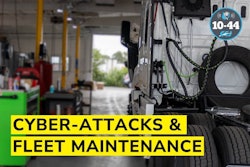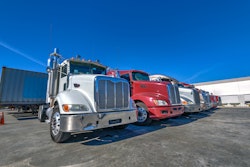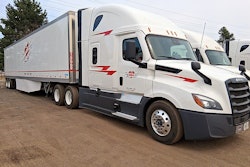Tires are one of fleets' biggest annual expenses, only behind fuel, equipment, maintenance and insurance.
Many fleets today utilize tire pressure monitoring systems to monitor tire health, but by looking deeper into the data, fleets can be more proactive to save on their tire spend.
Joining us this week is Adam McElhinney, CEO of predictive maintenance tech firm Uptake, who talks about a new suite of products that Uptake just launched that will give fleets more insight into their tires.
Contents of this video
00:00 10-44 intro
00:30 Tire maintenance
01:07 What does Uptake do?
03:29 Tire Insights products
06:59 Tire pressure monitoring systems
07:56 Early leak detection
10:06 Tire Insights positive results
Jason Cannon:
CCJs 10 44 is brought to you by Chevron Delo, heavy duty diesel engine oil. Now there's even more reasons to choose Delo.
Matt Cole:
Tires are one of fleet's biggest expenses. How data-driven insights can help control those costs.
Jason Cannon:
You're watching CCJs 10 44, a weekly episode that brings you the latest trucking industry news and updates from the editors of CCJ. Don't forget to subscribe and hit the bell for notifications so you'll never miss an installment of 10 44. Hey everybody, welcome back. I'm Jason Cannon and my co-host is Matt Cole. According to the American Transportation Research Institute's 2023 operational cost of trucking report. Tires are the number five expense for fleets on average behind fuel, equipment, repair and maintenance and insurance.
Matt Cole:
Many fleets today utilize tire pressure monitoring systems to monitor tire health, but by looking deeper into the data, fleets can be more proactive to save on their tire spend. Join us this week is Adam McElhinney, CEO of predictive maintenance tech firm Uptake, who talks about a new suite of products that just launched that will give fleets more insight into their tires.
Adam McElhinney:
Uptake is an IOT and data analytics company. Our trucking industry products really sit in between the TSPs and the maintenance systems where we ingest all the signal data that's coming off the engines. We then put them through a series of proprietary machine learning algorithms that we've developed, and then we figure out what issues you're going to have with the truck, and we recommend what repairs to resolve those issues and then integrate that back into the maintenance system. Then we can figure out was that repair resolved and then pull that back into our system so we can close that loop and retrain those machine learning algorithms. We tell customers there's really four sources of value, so the first is preventing imminent failures. This is where our algorithms detect, Hey, your truck has an issue right now, you need to pull over and get to the service shop right away.
This is the most dramatic or most identifiable source of value that customers see in practice, so it doesn't happen a ton. I mean, most fleets are fairly well maintained these days, and these are pretty modern trucks that we're typically dealing with, but when we get a save like that, it's really exciting for both the customer and for uptake as well. The second way we tell customers we add value is through what we call PM bundling. So this is where we can detect an issue with the truck, and it's not an imminent failure. You don't need to stop your route. You don't need to pull over right now, but this is where, hey, next time that truck's going to be in the shop for its regularly scheduled preventative maintenance, you should also check out X, Y, Z issues on the truck. That's where most customers see the most.
That's the biggest bucket of value that customers see. Third thing customers use this for is what we call driver deescalation. So let's say you're driving around, you're doing a day route, some lamp comes on in your cab, call the boss, Hey, what should I do with this? He'll pull up your truck and uptake and say, that's probably a false positive. You're probably good. Keep doing your route. We'll take a look at it when you get back in the shop at the end of the day or in a couple days when you're back at wherever your truck's domiciled. And then fourth way customers really use our platform is what we call targeted campaigns. So this is where we'll zoom out. It'll say, Hey, here's the issues that your fleet's having over time, month over month, quarter over quarter, and how it compares to other fleets that might be similar to you. And then you might think about making some changes into what your maintenance schedule is or how you're maintaining your assets.
Jason Cannon:
Adam says that uptakes fleet customers highlighted tires is a pain point for their business. Now, this led to the creation of the company's new Tire Insights products
Adam McElhinney:
And something we kept hearing from customers was, Hey, we really have a lot of cost reduction initiatives that are scheduled right now. Spot prices remain low. Some people, they talk about the fleet recession and tires is a big area of spend for us. For most of our customers, tires is the fourth largest area of spend that they have. Also, there's a bunch of safety concerns when a tire breaks down on the side of the road, and there's operational implications to this as well. So customers clearly told us that saving money was a big concern of theirs and that tires are a big pain point for them. Some of our sophisticated customers will have dedicated tire programs and folks just dedicated to ensuring the health and maintenance of their tires and ensure they're optimizing costs on their tires. So they clearly were telling us this was an issue.
Then we started looking at, okay, what data might be available? And we're seeing a lot more customers implement ADAS systems or TPMS systems, either that are in the valve stem or in the tire or on the wheel itself. So we said, okay, we think there's potentially a really exciting product here. So we worked with some customers to get access to their tire data. We unleashed our data science resources on it, and they started building machine learning models around tire failures. And then we've been beta testing those right now, and customers are seeing like 83 to 90% reduction in unplanned tire failures. So we're in the process of rolling out that product right now, and the feedback from customers has been very strong.
Matt Cole:
Adam explains that uptake leverages data from existing tire pressure monitoring systems and other tire monitoring devices to create actionable insights. We'll hear how after word from 10 44 sponsor Chevron lubricants.
Speaker 4:
These past few years have been less than easy. We've encountered challenges we never imagined we'd ever have to deal with from makeshift home offices and video meetings to global supply chain uncertainty, price instability, market disruptions, and everything in between. Delivering the level of services and products our customers had come to expect was difficult for all of us. We can't change what's behind us, but we can definitely learn from it. We can adapt, evolve, and take steps to reset our thinking, adapt our strategies, and restore your trust in us to better meet your needs now and in the future. That change begins today. Today we break with convention and introduce a rebalance line of Delo heavy duty engine oils. We've reduced our product line from four categories to two consolidated and simplified. This lineup removes complexity from the manufacturing processes, enhancing price stability, and supply chain reliability so you can trust you'll have the premium products you need to keep your business always moving forward. Our break with convention optimizes the delo lineup to allow you to provide your customers with the best synthetic blend and synthetic heavy duty engine oils in the market, fully available at prices you can rely on. It's your assurance that you'll be well positioned to be their trusted source for proven engine protection that keeps equipment on the job, giving your customers even more reasons to choose delo.
Adam McElhinney
Today we're piggybacking on the sensor data, either that's coming from the ADA systems or the TPMS sensors. We've really seen a lot of trucking companies adopt this functionality in the past couple of years. I think maybe 10 years ago it was much more uncommon, but a lot more customers are instrumenting trailers and tires than they historically have, so that data already exists. Many times it's already flowing to customers and they're not leveraging it, or many times they're just leveraging kind of OEM fault codes related to that. They're seeing a ton of false positives. They're saying like, Hey, this thing, if it gets cold quickly, I'm getting alerts, or just a lot of false positives. So that data already exists for us in most cases, which is great. We can then pull that into the uptake platform, combine that with previous repair history plus other telematics information about the truck. Is it under load? Is this a problematic truck that's had a bunch of issues in the past? And then use that to fuel our tire insights.
Jason Cannon:
One part of the product line is an early leak detection, which Adam says can help prevent a complete failure while you're out on the
Adam McElhinney:
Road. So early leak detection is really the name of the game. Telling somebody that they have a tire issue when they're already pulled over on the side of the road with a blowout doesn't really help anyone. Right? So there's three sources of value that the tire product brings. So one is early leak detection like you mentioned. Because we have such a huge volume of data and because we have data from multiple industries and multiple sources from the truck, we can really make more robust analytics than somebody who's just coding up kind of a fault code for one OEM or one manufacturer. Those are typically designed based on subject matter expertise, and there's a lot of value and subject matter expertise, don't get me wrong, but we can really zoom out and aggregate that at just a much larger scale. Also, one of the challenges with this, if you actually plot the tire pressures over time, as the trucks moving around, you typically see quite a bit of variance.
That variance is determined by ambient temperatures. That variance is determined by the truck speed. The variance is determined by how much load that truck or that trailer are under. So it's not like it's really tough to just set a static rule and say, okay, if it exceeds these bounce and you have an issue, because you're going to see, you almost see this sawtooth pattern throughout the day as the truck's operating. So you really need more sophisticated machine learning to detect those early leaks, and that's where we've made a huge investment. The other benefit of this product is really around fuel economy. The DOT publishes some statistic. It's something like for every two PSI or underinflated, it's like a 0.1% decrease in fuel economy. I probably got the specific numbers wrong, but that's kind of the order magnitude that we're talking about there. And then something else we're going to be releasing soon is tire TPMS sensor model. So what we've learned in our beta trials is these sensors actually can get installed incorrectly, or they'll frequently just break. And so obviously if you're paying all this money for these sensors, but they're not giving you accurate data, then you're not going to get any of the insights. So that's an area where we're really excited to expand the product in the near future based on beta customer feedback
Matt Cole:
Uptake fully launched the Tire Insights products this week, but it has been working with a number of fleets testing the system before this who have reported positive results.
Adam McElhinney:
The feedback we've gotten has been a couple items. One, customers are very, very excited about this as a general initiative and priority for them. Like I mentioned, these fleets are under immense pressure to optimize costs and tires are a huge cost for them. So there's just a lot of excitement about what we can do around fuel costs and tire costs. Second, customers are seeing big impact. We're seeing customers have around mid 80% reduction in unplanned tire failures as a result of this. Third, customers are telling us, Hey, the product's great. The tire insights are great, but we're actually having issues with the TPMS sensors. So that's why we're coming back and expanding the product to offer a new class of insights that don't just detect the issues with the tires, but detect issues with those TPMS sensors.
Jason Cannon:
That's it for this week's 10 44. You can read more on ccj digital.com. While you're there, sign up for our newsletter and stay up to date on the latest in trucking industry news and trends. If you have any questions or feedback, please let us know in the comments below. Don't forget to subscribe and hit the bell for notifications so you can catch us again next week.










